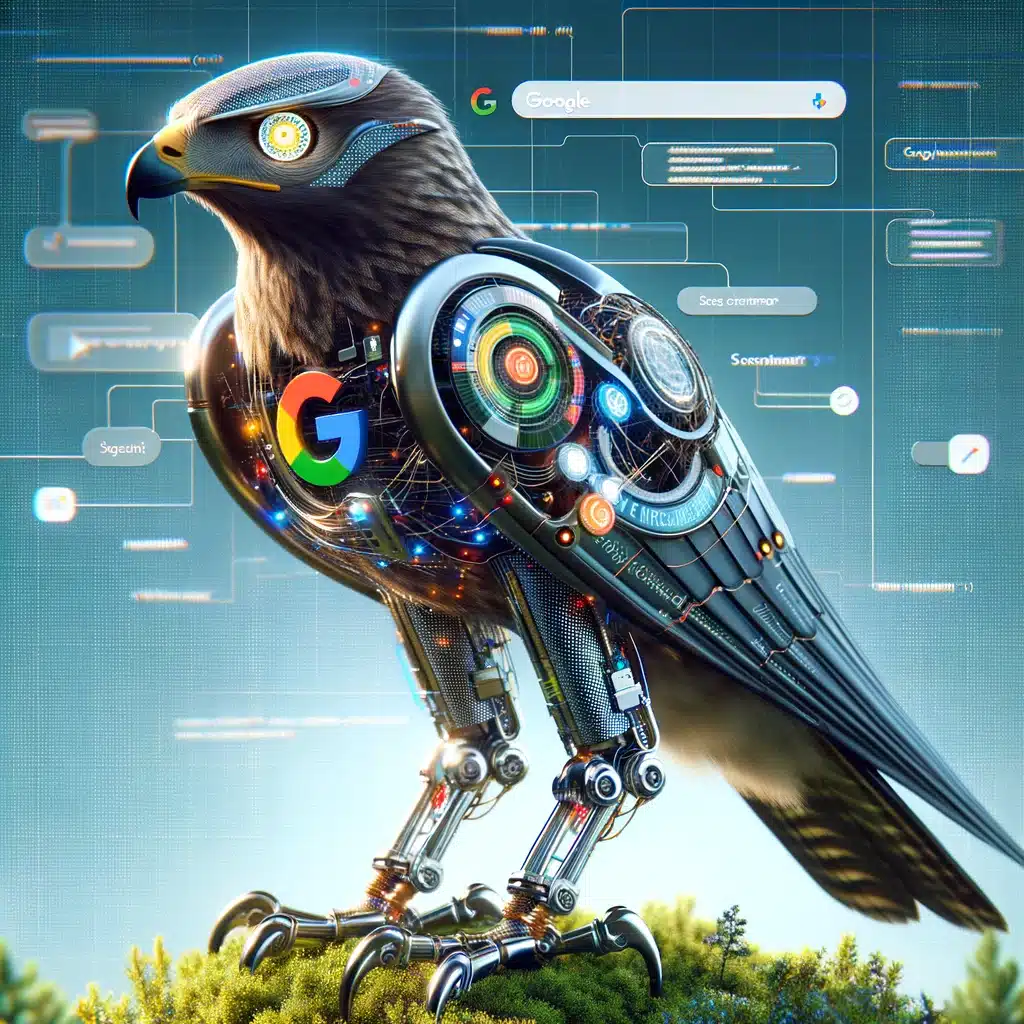The TL;DR
- To perform effective search engine optimization (SEO), it’s crucial to understand how search engines operate.
- They function in three main steps: crawling, indexing, and serving search results.
- Crawling involves bots discovering new content online, indexing organizes and stores this content, and serving delivers the most relevant results to user queries.
- Key ranking factors include the user’s intent, content relevance, quality, usability, and context.
- Recent trends in search technology emphasize AI, multimedia, and privacy concerns are impacting search engine algorithms.
Introduction to Search Engines
What is a Search Engine?
A search engine is software that searches a database to locate specific information based on user-provided keywords. Think of search engines as digital libraries that you can browse through.
How Do Search Engines Work?
With search engines like Google or Bing, a search takes place in 3 steps. Google suggests these are their three steps:
- Step 1: Crawling: Google uses crawling technology to deploy bots (spiders) across the Internet to identify text, images, and videos from web pages.
- Step 2: Indexing: Google then analyzes the text, images, and videos found to understand them and stores them in its database within the correct datasets.
- Step 3: Serving Search Results: When a user uses Google and searches for a search query, Google will then show the most relevant result.
Please note, however, that not all pages make it through each stage.
They must fulfill specific requirements to be crawled, indexed, and served on Google.
You’ll also find that Bing has the same process.
The Purpose of Search Engines
The primary goal of search engines is to help the user search for and find information.
For example, on Google, if you type in “How do search engines work?” it’ll search through its database and show you the datasets related to that keyword.
How Search Engines Crawl the Web

Understanding Web Crawlers
A web crawler, a spider, is a bot a search engine will deploy to discover new content online. The process can also be called “URL Discovery.” Platforms like Google and Bing deploy billions of these crawlers, helping them find new content to store in their search indexes.
Remember, web crawlers are bots, so web pages should be structured so they can read them. To do this, you want to follow schema-structured data rules. These can improve the readability of your website’s HTML from a crawler’s perspective.
Technologies Behind Crawling
Depending on the search engine, different technologies are used. Google, for instance, uses something called Googlebot to fetch data. On the other hand, Bing uses Bingbot as its standard crawler.
The Indexing Process

What is Indexing?
Search engine indexing is the process where search engines analyze, organize, and store web pages in their central databases.
During this process, search engines like Google identify duplicate content and determine the canonical version (the primary version of a web page), which is prioritized in search results.
Google also learns more about the page, such as the language, geographic relevance, and usability.
Challenges in Indexing
The main problem with indexing big data, such as the Internet, is that most index structures fail to meet the growing data management needs. The same is true for search engine indexing.
Alongside this, it’s an automated process completed by web crawlers (aka bots). Therefore, you must fulfill algorithmic requirements to rank “high” in the index.
It’s important to note that search engines do not index all web pages. This can either be done by the website owners or by crawlers deeming the quality and page experience as “poor.”
Ranking Algorithms
How Ranking Works
Search engines use algorithms to analyze websites and determine their Page Rank. A web page’s page rank determines where it ranks in the search results of a given search.
Factors Influencing Search Rankings
Google looks at five key factors when determining a page’s rank within search results. These include:
- Meaning: Aims to understand the user’s intent behind the search query.
- Relevance: Assesses how well the content on a page matches the user’s query.
- Quality: Prioritizes content that it deems as high-quality.
- Usability: Follows a mobile-first index, so they’re looking for sites that can be accessed on mobile devices.
- Context: Personalizes search results based on the user’s location, language, past search history, and search settings.
Search Engine Updates and Innovations
Recent Updates to Search Algorithms
Google released two major updates in 2024: the March 2024 Core Update and the March 2024 Spam Update.
Starting with the Core Update, Google wanted to improve the quality of search results by removing content created for clicks and replacing it with valuable, people-first content.
They have done this by introducing new spam policies and addressing problems that can negatively impact search results.
The Spam Update aided this, as well. With the rise of poorly written AI content, Google introduced the Spam Update to reduce low-quality, unoriginal results.
This was rolled out by improving quality search engine ranking factors and introducing new spam policies. From Match 5th to April 19, Google suggests a 45% decrease in low-quality, unoriginal content from this update.
Bing, on the other hand, recently released their IndexNow tool. This tool allows you to inform Bing about recent content changes to gain access to instant indexing.
Future Trends in Search Technology
Search engines constantly change, ensuring they stay up-to-date with user requirements.
Based on changing user requirements, here’s how search technology will change:
- AI: With Google’s latest spam update, AI content may be penalized in search results. Quality AI content, probably not. However, poor, one-click content, yes.
- Multimedia: Gone are the days of text-only content. Users want video, text, and audio; future search updates will reflect this.
- SGE (Search Generative Experience): Using generative AI, Google answers search queries with links to where they sourced the information, making structured data more critical.
- AI Overviews: This is the new version of SGE, and it will start rolling out on May 14 and May 14.
Of course, there are many more future trends to consider. However, the mentioned are the top trends to know.
Privacy and Search Engines
How Search Engines Handle User Data
Most search engines, apart from a small selection, collect user data. They do this to sell advertisements (which requires an understanding of the user type) and to provide the best possible results to users when browsing.
Typically, search engines abide by general online privacy rules like the U.S. Privacy Act (1974) and the GDPR for those in the European Union. They also follow data retention and sharing policies.
Privacy Concerns with Search Engines
Since the beginning of search engines, privacy has always been a concern.
Search engines can log individual search queries, browsing histories, cookies, IP addresses, and more for user profiling. Collecting this information is called personally identifiable information (PII) (tracking).
There have been breaches of search engines. Two of the most well-known ones were AOL and Yahoo, where millions of their data were stolen.
Impact of AI on Search Engines

AI Advancements in Search Technology
For a long time now, AI has helped search engines drive innovation. However, lately, we’ve seen AI advancements like no other.
First, look at Google’s new search figure, “Circle to Search“. Though only available on Android, it allows you to use AI to image search from apps (such as Instagram) to Google without leaving the app. This puts a stronger focus on image search.
Next, you have Azure AI Search from Microsoft. This is unlike other generative AIs like ChatGPT. Instead, they are information-retrieval software, improving how users search for data.
Also, all search engines will improve their understanding of the searcher’s intent by using AI and ML (Machine Learning) collaboratively. This will provide a richer, more personalized experience to the end user.
Future AI Integrations in Search Engines
The future of search engines, with the help of AI, will result in a better user experience. It’ll help improve:
- Search personalization.
- Visual identification.
- Shopping experiences.
- Language barriers.
- Accessibility for all (those with visual impairments, language disability, etc.).
Search is all about user experience and how they can answer the query the fastest and most effectively. With this in mind, AI can help understand users on a deeper level, providing search engines with much-needed information to innovate.
FAQ
What is a search engine crawler?
Search engine crawlers, spiders, or bots are automated programs search engines use to discover and analyze website content.
How often do search engines update their algorithms?
Not all algorithm updates are made public. However, SEO experts suggest that search algorithms are updated 500 to 600 times yearly.
What is the difference between crawling and indexing?
Crawling involves search engines discovering and accessing web pages, whereas indexing organizes and stores the information found during a crawl.
Conclusion
After reading the above, you should understand the SEO basics well.
Search engines work in three steps: crawling, indexing, and serving search results. They carefully process each step to provide the user with the highest-quality experience.
Contact me if you still need to figure out search engines or want SEO advice.
I’m Lawrence Hitches, an SEO consultant from Melbourne who has won awards such as the APAC Search Awards 2023 and the SEMrush Search Awards Australia.
If you need me, I’m always here to help.


